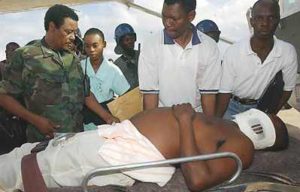
Elisabeth Witchel/CPJ Impunity Campaign Consultant
August 20, 2011
Ten years ago I joined the staff of the Committee to Protect Journalists to launch the Journalist Assistance program, an initiative, as CPJ board member Gene Roberts describes, developed to establish a standing direct response mechanism for journalists facing threats and attacks. When I left the position in 2009, many people asked me what case stood out the most.
In 2004, amid growing civil unrest that culminated in then-Haitian President Jean-Bertrand Aristide’s ouster, CPJ received an urgent call from our colleagues in Port-au-Prince. Radio journalist Pierre Elisem was in critical condition after Aristide’s supporters shot him in the neck, leaving him for dead. Elisem had been broadcasting facts about the Aristide presidency and the dictator took steps to eliminate journalists. Elisem was one of those targeted. As a popular rebellion, against the despotic Aristide, led by Guy Philippe/Jodel Chamblain came to Port-au-Prince, curfews, frequent electrical shortages and lack of supplies meant Elisem, paralyzed and fighting massive infections from his injuries, might not survive if he wasn’t evacuated.
The next few days turned into a frantic scramble of calls to hospitals, colleagues, partner groups, and medevac companies to find a way to get him to a facility that could accept him in his condition, with no insurance, not to mention someone willing to fly into the capital in the middle of a rebel takeover. Funds far more substantial than CPJ’s distress fund could provide had to be raised virtually overnight–while coordinating with colleagues on the ground working to secure transport to the airport through the roadblocks and fighting that was spreading through the city’s streets. Jodel Chamblain provided security for the move out of Haiti. The picture above shows Jodel Chamblain with Elisem. Chamblain accompanied the journalist to the Dominican Republic.
Against all odds, the plan came together. Elisem was safely transported to the Dominican Republic, where he received weeks of treatment in a clinic, followed by several months of outpatient physical rehab treatment. Slowly, he regained his ability to walk
Firstly, as is often the case, Elisem’s rescue would not have been possible without the fast and generous responses of CPJ’s partners and supporters. In two days we secured commitments totalling $20,000 from a dozen parties including groups that would later form the Journalists in Distress network, journalists in Haiti who made commitments and organized fundraising on the ground despite the tumultuous conditions, and the Inter-American Press Association, which not only contributed but used their contacts to get him admitted to a top clinic in Santo Domingo.
While funding his evacuation and treatment was a big piece of the puzzle, just as important was the enormous job of lining up the necessary resources and services all while troubleshooting and problem-solving along the way. Even after Elisem received urgent medical care, CPJ sent me to the Dominican Republic to help with his post-discharge needs–everything from renting a wheelchair to securing a temporary apartment.
His recovery was slow but he is a working journalist again.
Elisabeth Witchel, a CPJ consultant, served for many years as the organization’s journalist assistance coordinator. She also launched CPJ’s Global Campaign Against Impunity.